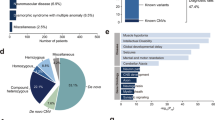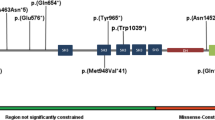Abstract
Background
Aromatic L-amino acid decarboxylase (AADC) deficiency is an autosomal recessive neurotransmitter metabolism disorder and is clinically characterized by infancy hypotonia, ophthalmic crisis, and developmental delay. With the emergence of gene therapy for AADC deficiency, accurate prediction of AADC deficiency is required. This study aimed to analyze the carrier frequency and expected incidence of AADC deficiency using exome data from the Genome Aggregation Database (gnomAD).
Methods
We analyzed 125,748 exomes from gnomAD, including 9197 East Asian exomes, for the DDC gene. All identified variants were classified according to the 2015 American College of Medical Genetics and Genomics and the Association for Molecular Pathology guidelines.
Results
The worldwide carrier frequency of AADC deficiency was 0.17%; the highest frequency was observed in East Asians at 0.78%, and the lowest was in Latinos at 0.07%. The estimated incidence of AADC deficiency was 1 in 1,374,129 worldwide and 1 in 65,266 in East Asians.
Conclusion
The results demonstrated that East Asians have a higher carrier frequency of AADC deficiency than other ethnic groups. The variant spectrum of DDC genes in East Asian populations differed greatly from those of other ethnic groups. Our data will serve as a reference for further investigation of AADC deficiency.
Impact
-
This study analyzed exome data from the Genome Aggregation Database (gnomAD) to estimate the carrier frequency and expected incidence of aromatic L-amino acid decarboxylase (AADC) deficiency.
-
The article provides updated carrier frequency and incidence estimates for AADC deficiency, particularly in East Asian populations, and emphasizes the significant differences in the variant spectrum of DDC genes in this population compared to other ethnic groups.
-
The study provides important information for accurate prediction and early diagnosis of AADC deficiency, particularly in high-risk populations, and may aid in the development of more effective targeted screening programs and gene therapies for this disorder.
This is a preview of subscription content, access via your institution
Access options
Subscribe to this journal
Receive 14 print issues and online access
$259.00 per year
only $18.50 per issue
Buy this article
- Purchase on Springer Link
- Instant access to full article PDF
Prices may be subject to local taxes which are calculated during checkout
Similar content being viewed by others
Data availability
All data are available by the corresponding author upon reasonable request.
References
Hyland, K. & Clayton, P. T. Aromatic amino acid decarboxylase deficiency in twins. J. Inherit. Metab. Dis. 13, 301–304 (1990).
Brun, L. et al. Clinical and biochemical features of aromatic L-amino acid decarboxylase deficiency. Neurology 75, 64–71 (2010).
Abeling, N. G. et al. Pathobiochemical implications of hyperdopaminuria in patients with aromatic L-amino acid decarboxylase deficiency. J. Inherit. Metab. Dis. 23, 325–328 (2000).
Whitehead N. et al. Estimated prevalence of aromatic L-amino acid decarboxylase (AADC) deficiency in the United States, European Union, and Japan (2018)
Chien, Y. H. et al. 3-O-methyldopa levels in newborns: result of newborn screening for aromatic L-amino-acid decarboxylase deficiency. Mol. Genet Metab. 118, 259–263 (2016).
Hyland, K. & Reott, M. Prevalence of aromatic L-amino acid decarboxylase deficiency in at-risk populations. Pediatr. Neurol. 106, 38–42 (2020).
Lee, H. F., Tsai, C. R., Chi, C. S., Chang, T. M. & Lee, H. J. Aromatic L-amino acid decarboxylase deficiency in Taiwan. Eur. J. Paediatr. Neurol. 13, 135–140 (2009).
Pearson, T. S. et al. Gene therapy for aromatic L-amino acid decarboxylase deficiency by MR-guided direct delivery of AAV2-AADC to midbrain dopaminergic neurons. Nat. Commun. 12, 4251 (2021).
Tai, C. H. et al. Long-term efficacy and safety of eladocagene exuparvovec in patients with AADC deficiency. Mol. Ther. 30, 509–518 (2022).
Karczewski, K. J. et al. The mutational constraint spectrum quantified from variation in 141,456 humans. Nature 581, 434–443 (2020).
Richards, S. et al. Standards and guidelines for the interpretation of sequence variants: a joint consensus recommendation of the American College of Medical Genetics and Genomics and the Association for Molecular Pathology. Genet. Med. 17, 405–424 (2015).
Ioannidis, N. M. et al. Revel: an ensemble method for predicting the pathogenicity of rare missense variants. Am. J. Hum. Genet 99, 877–885 (2016).
Jaganathan, K. et al. Predicting splicing from primary sequence with deep learning. Cell 176, 535–548.e524 (2019).
Himmelreich, N. et al. Spectrum of DDC variants causing aromatic l-amino acid decarboxylase (AADC) deficiency and pathogenicity interpretation using ACMG-AMP/ACGS recommendations. Mol. Genet Metab. 137, 359–381 (2022).
Gregg, A. R. et al. Screening for autosomal recessive and X-linked conditions during pregnancy and preconception: a practice resource of the American College of Medical Genetics and Genomics (ACMG). Genet. Med. 23, 1793–1806 (2021).
Hwu, W. L., Chien, Y. H., Lee, N. C. & Li, M. H. Natural history of aromatic L-amino acid decarboxylase deficiency in Taiwan. JIMD Rep. 40, 1–6 (2018).
Dai, L., Ding, C. & Fang, F. A novel DDC gene deletion mutation in two Chinese mainland siblings with aromatic L-amino acid decarboxylase deficiency. Brain Dev. 41, 205–209 (2019).
Wassenberg, T. et al. Consensus guideline for the diagnosis and treatment of aromatic L-amino acid decarboxylase (AADC) deficiency. Orphanet J. Rare Dis. 12, 12 (2017).
Acknowledgements
The authors are grateful to those responsible for creating and maintaining gnomAD, ClinVar, and HGMD database.
Funding
This research was supported by Basic Science Research Program through the National Research Foundation of Korea (NRF) funded by the Ministry of Education (NRF-2021R1I1A1A01049183) and the research fund of Hanyang University (HY-202300000001152).
Author information
Authors and Affiliations
Contributions
J.E.P. participated in the analysis and interpretation of the data and the drafting of the manuscript. E.H.C. participated in the analysis and interpretation of the data. T.L. and K.H. participated in the acquisition and analysis of data. C.-S.K. and J.E.P. participated in the study concept and design, the drafting of the manuscript, and important intellectual content.
Corresponding author
Ethics declarations
Competing interests
The authors declare no competing interests.
Ethics approval
This study was approved by the Institutional Review Board of Hanyang University Guri Hospital (2021-06-029) and conducted in accordance with the Declaration of Helsinki.
Additional information
Publisher’s note Springer Nature remains neutral with regard to jurisdictional claims in published maps and institutional affiliations.
Supplementary information
Rights and permissions
Springer Nature or its licensor (e.g. a society or other partner) holds exclusive rights to this article under a publishing agreement with the author(s) or other rightsholder(s); author self-archiving of the accepted manuscript version of this article is solely governed by the terms of such publishing agreement and applicable law.
About this article
Cite this article
Park, J.E., Lee, T., Ha, K. et al. Carrier frequency and incidence of aromatic L-amino acid decarboxylase deficiency: a gnomAD-based study. Pediatr Res 94, 1764–1770 (2023). https://doi.org/10.1038/s41390-023-02685-0
Received:
Revised:
Accepted:
Published:
Issue Date:
DOI: https://doi.org/10.1038/s41390-023-02685-0
This article is cited by
-
Detection of hidden intronic DDC variant in aromatic L-amino acid decarboxylase deficiency by adaptive sampling
Journal of Human Genetics (2024)



